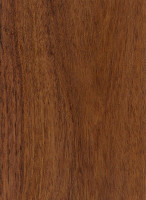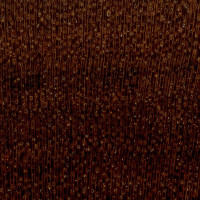 |
Common Name(s): Mopane, Mopani Scientific Name: Colophospermum mopane Distribution: Southern Africa Tree Size: 65-100 ft (20-30 m) tall, 2-3 ft (.6-1.0 m) trunk diameter Average Dried Weight: 67 lbs/ft3 (1,075 kg/m3) Specific Gravity (Basic, 12% MC): .88, 1.08 Janka Hardness: 3,390 lbf (15,060 N) Modulus of Rupture: 16,530 lbf/in2 (114.0 MPa) Elastic Modulus: 1,917,000 lbf/in2 (13.22 GPa) Crushing Strength: 10,190 lbf/in2 (70.3 MPa) Shrinkage: Radial: 4.0%, Tangential: 5.2%, Volumetric: 9.3%, T/R Ratio: 1.3 |
Color/Appearance: Heartwood is medium to dark reddish brown, with black stripes. Color tends to darken with age. Well-defined sapwood is a pale yellow.
Grain/Texture: Grain is usually interlocked. Fine uniform texture with a moderate natural luster.
Endgrain: Diffuse-porous; solitary and radial multiples; medium to large pores in no specific arrangement, few to moderately numerous; heartwood mineral/gum deposits common; parenchyma vasicentric, banded; narrow rays, spacing normal to fairly close.
Rot Resistance: Mopane is rated as very durable, and is also resistant to termites and powder post beetles.
Workability: Mopane is generally considered to be difficult to work, mainly on account of its incredibly high density. Machining has a severe blunting effect on cutters. Mopane is excellent for turned objects.
Odor: No characteristic odor.
Allergies/Toxicity: Besides the standard health risks associated with any type of wood dust, no further health reactions have been associated with Mopane. See the articles Wood Allergies and Toxicity and Wood Dust Safety for more information.
Pricing/Availability: Likely to be somewhat expensive, exceeding the cost of most imported African hardwoods, with the exception of the scarcer species such as Pink Ivory or African Blackwood.
Sustainability: This wood species is not listed in the CITES Appendices or on the IUCN Red List of Threatened Species.
Common Uses: Flooring, musical instruments (woodwind), turned objects, fuelwood/charcoal, furniture, inlay, and exterior construction.
Comments: Mopane is an often neglected and overlooked African hardwood, though its density and durability are virtually unrivaled. The wood is also said to have excellent acoustic properties, comparing similarly to African Blackwood—at a more economical price.
None available.









To me this is perfect wood to make flutes. Very very good finish and polished. See an picture
Today I turned an 8×3 bowl from a KD Mopane blank. Side gtrain and end grain cutting present serious differences. While side grain cuts are glass smooth, end grain is brittle and prone to tearout. Since the grain is very fine, tear-out is not deep but the pores are fill up with dust. I cleaned the surface with alcohol after every grit. Frequent gouge sharpening is necessary, and helps mitigate the tear-out. I found the wood to have a distinctive odor during turning. It smells to me like scorched ketchup. The wood takes a very huigh polish and has beautiful… Read more »
I know this is outside of woodworking, but I think it’s interesting that mopane is actually quite common in fish-keeping circles. Raw branches come in interesting shapes and its density means it sinks easily and lasts a long time as aquatic decor.
Surprised no one has commented yet. This wood is great for turning, especially if you can find it already dead, dried, and on the ground. It is extremely hard, and is rough on tools. I have found that carbide tools work best. For roughing, because of its hard, brittle nature, the shards coming off the lathe can really hurt. Wearing a glove, and mask make a big difference. Be careful when approaching your final dimension. The sharper the better your finish and less sanding. It can be difficult and take a long time getting deep sanding grooves out. It takes… Read more »